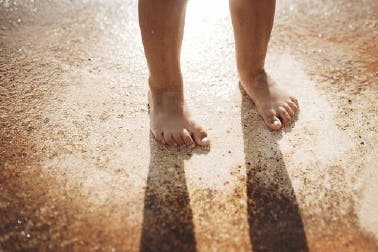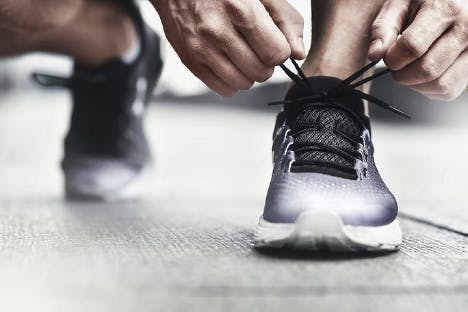Just a casual look at women's dress shoes immediately leads one to suspect that maybe we would be better off without shoes. Through the 80s, my wife was always anxious to get out of her office high heels as soon as possible. Obviously, the human foot was not created to walk on a 3-inch pedestal. Thankfully, more practical footwear is now available and acceptable. But what about walking, running, and other sports shoes? Would we be better off barefoot like primitive humans and our primate cousins? If so, why did humans develop shoes in the first place, and what became of the barefoot running craze?

Anybody that has walked barefoot on a gravel road, forest floor, or beach should understand why humans felt a need to protect the bottoms of their feet. Sharp gravel, sticks, and shells can bruise, pierce, or cut even a callused foot. Even athletes from African nations, such as Ethiopia’s Abebe Bikilaor, that competed barefoot at first, eventually jumped on the shoe wagon. He won the 1960 Olympic Marathon, running the streets of Rome barefoot. He was later sporting shoes for the 1964 Marathon. Warmth is another good reason for shoes. The warmth of footwear allows humans to exist in climates that would otherwise force seasonal migration in order to survive.

Protection and warmth are obvious benefits gained since primitive culture. Certain fashion trends likely give footwear a bad name, but sport shoes have been developed to improve athletic performance while protecting against injury. Some of the innovations have been good, some bad, and some ugly.

Shock absorption in the heels sounds like a great idea, but it led to a multitude of overuse injuries in the running community. Athletes had always run off the front of their feet until the shoe industry started to pad the heels of shoes in the 70s, believing that athletes should increase their stride with a heel strike. This likely set Western distance running back a few decades, as athletes struggled with the resulting overuse injuries. Kenyan and Ethiopian runners, meanwhile, dominated the distance events through the decades with little help from footwear.
Some other bad and ugly innovations include wide flares, springs in the heels, and rocker bottom soles. Do springs in the heels actually bounce you forward when you have the heel in front of you? How does a flared sole react to uneven terrain? Can a rocker bottom send you backwards as well as forward? Short message: “Avoid gimmicks.”
Growing up barefoot, the Africans naturally ran off their forefoot, as the human body was designed to function, and escaped the overuse injuries of the shod population. But why did they switch to shoes? Likely to avoid screws through the bottom of their feet. I have pulled a few out of my soles over the years. They have the best of both worlds: they are skilled at running with proper form, and protected from blunt trauma to the under foot. So the use of shoes is not necessarily bad, as long as you can still run with good form.
So what is good form? Pose running technique is a good example of a natural running form. At Clegg and Guest Physical Therapy, this natural movement form is taught to both runners and walkers of all ages. This form of movement engages the core muscles, limits joint stress, improves balance, and facilitates forward propulsion. Very few adults can successively convert to the Pose form of running or walking without professional guidance. Toddlers naturally use this technique, as it is the easiest way to balance as they learn to walk. The loss of this form usually occurs with the lack of physical activity and a dependence upon shoes that occurs with aging in our Western society.
So back to shoes - What is a good shoe? Pick one that is comfortable and makes you feel like moving forward. All else is secondary. At the top of my secondary list is the quality of construction and price. A good shoe is engineered to facilitate forward propulsion. This usually includes a small raise of the heels and an easy bend at the forefoot. The shoe should resist bend through the arch and collapse medially and laterally.

Knowing one’s foot type is essential for proper shoe selection. Hypermobile feet tend to collapse excessively into a pronated position. Certain shoes are designed to resist pronation. Those with a history of lateral ankle sprains require strength and support on the outer aspect of the shoe. A foot with a high instep typically requires more heel rise. Therapists at Clegg and Guest Physical Therapy have worked extensively with feet, especially in regards to restoring or improving one’s ability to walk or run without pain. We are happy to assist our clients in proper shoe selection, to avoid the bad, and the ugly.

